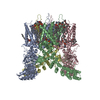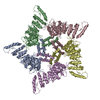+Search query
-Structure paper
| Title | A pentameric TRPV3 channel with a dilated pore. |
|---|---|
| Journal, issue, pages | Nature, Vol. 621, Issue 7977, Page 206-214, Year 2023 |
| Publish date | Aug 30, 2023 |
 Authors Authors | Shifra Lansky / John Michael Betancourt / Jingying Zhang / Yining Jiang / Elizabeth D Kim / Navid Paknejad / Crina M Nimigean / Peng Yuan / Simon Scheuring /  |
| PubMed Abstract | Transient receptor potential (TRP) channels are a large, eukaryotic ion channel superfamily that control diverse physiological functions, and therefore are attractive drug targets. More than 210 ...Transient receptor potential (TRP) channels are a large, eukaryotic ion channel superfamily that control diverse physiological functions, and therefore are attractive drug targets. More than 210 structures from more than 20 different TRP channels have been determined, and all are tetramers. Despite this wealth of structures, many aspects concerning TRPV channels remain poorly understood, including the pore-dilation phenomenon, whereby prolonged activation leads to increased conductance, permeability to large ions and loss of rectification. Here, we used high-speed atomic force microscopy (HS-AFM) to analyse membrane-embedded TRPV3 at the single-molecule level and discovered a pentameric state. HS-AFM dynamic imaging revealed transience and reversibility of the pentamer in dynamic equilibrium with the canonical tetramer through membrane diffusive protomer exchange. The pentamer population increased upon diphenylboronic anhydride (DPBA) addition, an agonist that has been shown to induce TRPV3 pore dilation. On the basis of these findings, we designed a protein production and data analysis pipeline that resulted in a cryogenic-electron microscopy structure of the TRPV3 pentamer, showing an enlarged pore compared to the tetramer. The slow kinetics to enter and exit the pentameric state, the increased pentamer formation upon DPBA addition and the enlarged pore indicate that the pentamer represents the structural correlate of pore dilation. We thus show membrane diffusive protomer exchange as an additional mechanism for structural changes and conformational variability. Overall, we provide structural evidence for a non-canonical pentameric TRP-channel assembly, laying the foundation for new directions in TRP channel research. |
 External links External links |  Nature / Nature /  PubMed:37648856 / PubMed:37648856 /  PubMed Central PubMed Central |
| Methods | EM (single particle) |
| Resolution | 2.55 - 4.38 Å |
| Structure data | EMDB-40181, PDB-8gka: EMDB-40183, PDB-8gkg: |
| Chemicals |  ChemComp-NA:  ChemComp-POV: |
| Source |
|
 Keywords Keywords |  MEMBRANE PROTEIN / MEMBRANE PROTEIN /  Ion Channel / Ion Channel /  TRP Channel / Closed Conformation / pore dilation TRP Channel / Closed Conformation / pore dilation |
 Movie
Movie Controller
Controller Structure viewers
Structure viewers About Yorodumi Papers
About Yorodumi Papers








